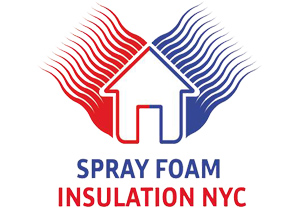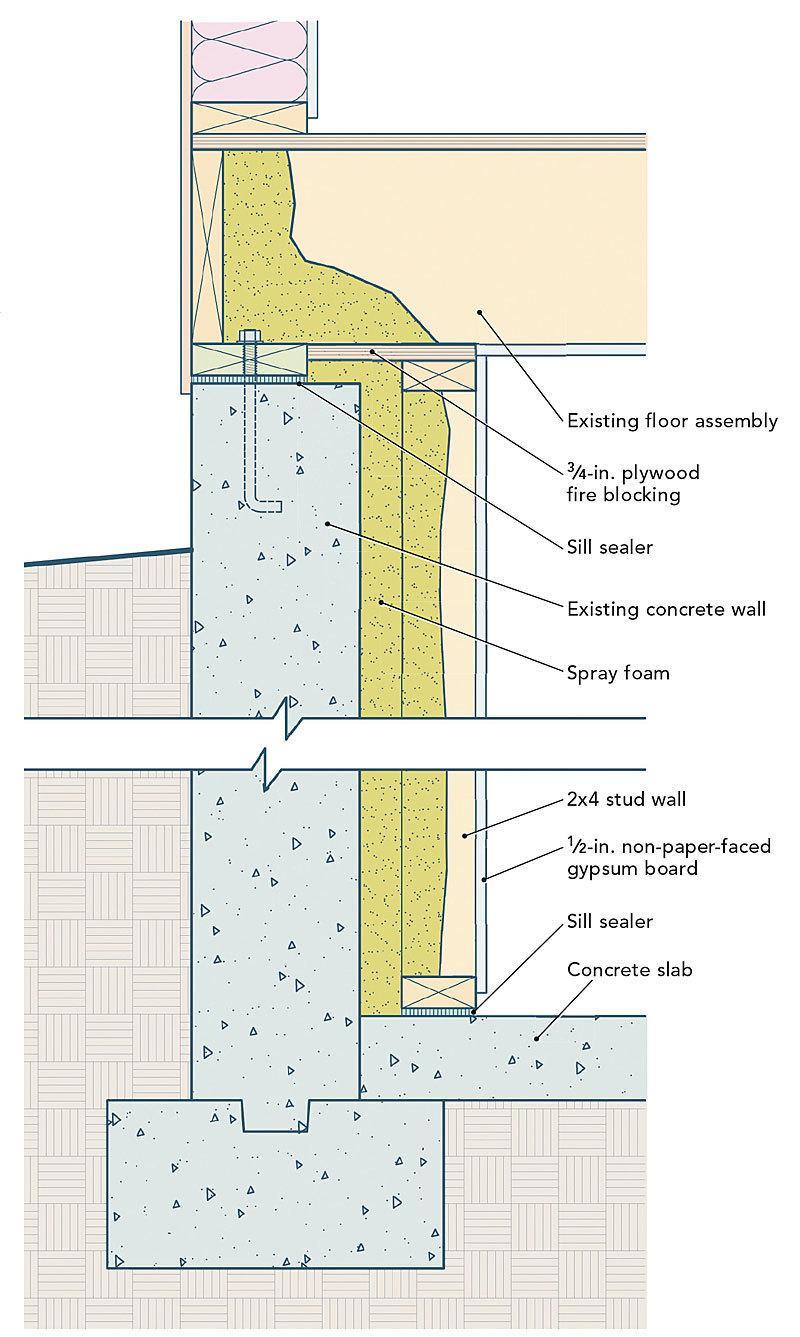How to Insulate my Basement Walls - Spray Foam insulation NYC
CLOSED-CELL FOAM
Make sure your basement is dry
Use foam insulation
Basement Insulation
Building codes require most types of foam insulation to be protected by a layer of gypsum drywall. Many builders put up a 2×4 wall on the interior side of the foam insulation; the studs provide a convenient wiring chase and make drywall installation simple. (If you frame a 2×4 wall, don’t forget to install fire blocking at the top of the wall.)
If your basement has stone-and-mortar walls, you can’t insulate them with rigid foam. The only type of insulation that makes sense for stone-and-mortar walls is closed-cell spray polyurethane foam.
If you plan to insulate your basement walls with Spray Foam, the best approach is to frame your 2×4 walls before the foam is sprayed, leaving a gap of 1-1/2 in. to 2 in. between the back of the studs and the concrete wall. The gap will be filled later with Spray Foam. If you live in an area where termites are a problem, your local building code may require that you leave a 3-in.-high termite-inspection strip of bare concrete near the top of your basement wall.
While reduced costs might tempt you to use fibrous insulation such as fiberglass batts, mineral-wool batts, or cellulose, these materials are air permeable and should never be installed against a below-grade concrete wall. When this type of insulation is installed in contact with concrete, moisture in the interior air can condense against the cold concrete surface, potentially leading to mold and rot.
Don’t worry about inward drying
Avoid polyethylene vapor barriers
Basement insulation is cost-effective
SPRAY FOAM INSULATION NYC – RESIDENTIAL & COMMERCIAL INSULATION CONTRACTOR SERVING NEW YORK CITY METRO AREA
WALLS - ATTICS - BASEMENT - ROOFING - SUBFLOOR - COLD STORAGE
Spray Foam offers higher thermal resistance (R-value) over outdated traditional methods such as fiberglass or cellulose and can be sprayed into areas that are difficult for other forms of insulation. With Spray Foam the underside of roof sheathing in attics and under your house in subfloor crawlspaces are completely insulated. Polyurethane Spray Foam insulation acts as an air barrier sealing off the hundreds of cracks and crevices that lets your conditioned air out and the outside air in.
Traditional insulating materials can’t do that. Because Spray Foam seals the building envelope, its R-value holds true. Fiberglass and cellulose rarely attain the R-value claimed because of air leakage in real-life applications.
Using Spray Foam can lead to greater energy savings by insulating your home more effectively. Used correctly in a new build, remodel or retrofit, an Spray Foam insulated home can use smaller Heating Ventilation and Air Conditioning (HVAC) units, saving even more money initially and more over time in energy savings.
Polyurethane Spray Foam Insulation can actually pay for itself over time with these savings. It is a one-time application that doesn’t sag or settle like out-dated fiberglass or cellulose and should last throughout the life of your home. No need to remove or replace saving landfill space.Truely a green insulation product!
High-tech Polyurethane Spray Foam Insulation is not new. It has been around for over 40 years. Originally used to insulate commercial refrigeration units. Why? Because it out performs everything else with less thickness.
Spray Foam is also great as a roofing system for flat and low-slope roofs. It is monolithic (one single piece with no laps or seams). A Spray Foam roof is also extremely light weight and can often be applied over existing roofs without costly tear offs or displacement of roofing felts containg asbestos (ACM). Spray Foam roofs are also “sustainable” and can be classified as “green”. This is because with proper care and periodical recoating, they can last more than 50 years! Most other roof systems last between 8-10 years. Each time costing as much as or more than before. With Spray Foam the initial cost may be more, but recoats are a fraction of what a new traditional roof would be.
The main advantage of a Spray Foam insulation system is that not only is it a roof, but it is a great insulator, something traditional insulation systems are not. As with Spray Foam in walls, it can start paying for itself immediately in energy and HVAC savings. By maintaining the roof, it will keep on paying for itself for years to come.
There are other benefits to using Spray Foam and we invite you to browse our website to learn more. Please visit our Library pages to read articles on Spray Foam and download some of our vendor’s brochures, see technical details and more. Our Gallery pages also show some of the Spray Foam work we have done recently. If you have other questions or would like us to give you an estimate on your project, you can fill out the online form in our Contact Us page or give us a call. We are more than happy to discuss the project with you! We proudly serve New York City Metropolitan Area
WHAT IS SPRAY FOAM?
BENEFITS
•Stops drafts allergens and condensation
•Better indoor air quality
•Does not settle or shrink
•Quieter indoor environment
•Fills irregular shapes
•Increased climate comfort
•Adds structural strength
•Seals cracks and voids
•Keeps out unwanted pests
WHICH AREAS OF MY HOME CAN I INSULATE?
Attic Insulation

Basement Insulation

Exterior Walls

Crawlspace

WHERE CAN SPRAY FOAM BE APPLIED
Spray foam insulation is a wildly diverse product in its features and benefits as well as its very unique ability to be applied to a vast range of substrates. We are going to take a look at a number of various substrates that Spray Foam can be applied to and what steps should be taken to ensure proper adhesion and performance of the foam insulation. A general for all substrates that one may work with when spraying foam is that they must be clean, dry, and free of grease, oil, loose scale or rust, etc. Another rule to follow when spraying onto a new, unknown substrate is to spray a small 2’ x 2’ test area first, leave to sit overnight, and test for adhesion the next day before continuing to spray.
Wood, Gypsum Board and Fiberboard:
Stainless Steel:
Glass:
Galvanized Steel:
Aluminum:
PVC Plastics:
Bare Steel:
Concrete:
Asphalt and Tar:
Serving Neighborhoods in New York City
Bronx Bronx Park and Fordham 10458, 10467, 10468
Bronx High Bridge and Morrisania 10451, 10452, 10456
Bronx Hunts Point and Mott Haven 10454, 10455, 10459, 10474
Bronx Kingsbridge and Riverdale 10463, 10471
Bronx Northeast Bronx 10466, 10469, 10470, 10475
Bronx Southeast Bronx 10461, 10462,10464, 10465, 10472, 10473
Brooklyn Central Brooklyn 11212, 11213, 11216, 11233, 11238
Brooklyn Southwest Brooklyn 11209, 11214, 11228
Brooklyn Borough Park 11204, 11218, 11219, 11230
Brooklyn Canarsie and Flatlands 11234, 11236, 11239
Brooklyn Southern Brooklyn 11223, 11224, 11229, 11235
Brooklyn Northwest Brooklyn 11201, 11205, 11215, 11217, 11231
Brooklyn Flatbush 11203, 11210, 11225, 11226
Brooklyn East New York and New Lots 11207, 11208
Brooklyn Greenpoint 11211, 11222
Brooklyn Sunset Park 11220, 11232
Brooklyn Bushwick and Williamsburg 11206, 11221, 11237
Manhattan Central Harlem 10026, 10027, 10030, 10037, 10039
Manhattan Chelsea and Clinton 10001, 10011, 10018, 10019, 10020, 10036
Manhattan East Harlem 10029, 10035
Spray Foam Insulation in NYC
Serving Neighborhoods in New York City
Manhattan Greenwich Village and Soho 10012, 10013, 10014
Manhattan Lower Manhattan 10004, 10005, 10006, 10007, 10038, 10280
Manhattan Lower East Side 10002, 10003, 10009
Manhattan Upper East Side 10021, 10028, 10044, 10065, 10075, 10128
Manhattan Upper West Side 10023, 10024, 10025
Manhattan Inwood and Washington Heights 10031, 10032, 10033, 10034, 10040
Queens Northeast Queens 11361, 11362, 11363, 11364
Queens North Queens 11354, 11355, 11356, 11357, 11358, 11359, 11360
Queens Central Queens 11365, 11366, 11367
Queens Jamaica 11412, 11423, 11432, 11433, 11434, 11435, 11436
Queens Northwest Queens 11101, 11102, 11103, 11104, 11105, 11106
Queens West Central Queens 11374, 11375, 11379, 11385
Queens Rockaways 11691, 11692, 11693, 11694, 11695, 11697
Queens Southeast Queens 11004, 11005, 11411, 11413, 11422, 11426, 11427, 11428, 11429
Queens Southwest Queens 11414, 11415, 11416, 11417, 11418, 11419, 11420, 11421
Queens West Queens 11368, 11369, 11370, 11372, 11373, 11377, 11378
Staten Island Port Richmond 10302, 10303, 10310
Staten Island South Shore 10306, 10307, 10308, 10309, 10312
Staten Island Stapleton and St. George 10301, 10304, 10305
Staten Island Mid-Island 10314

